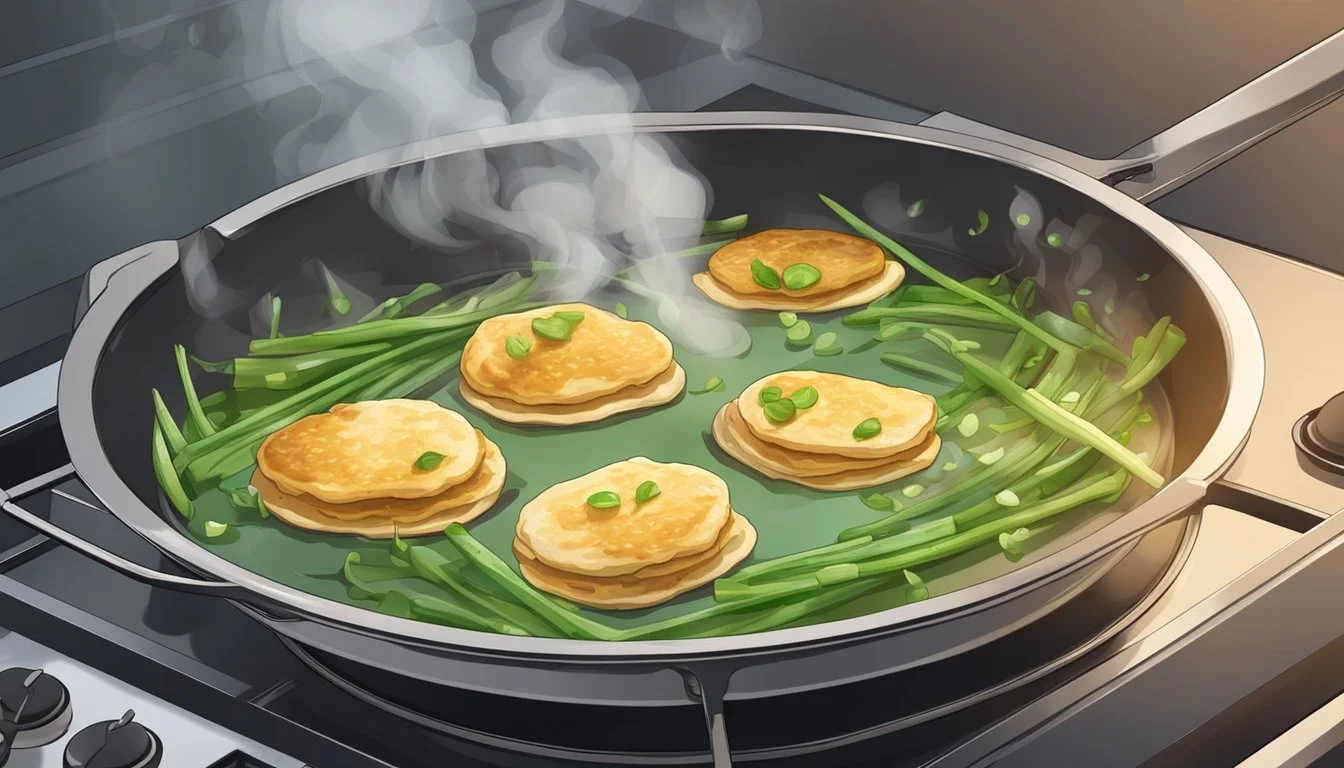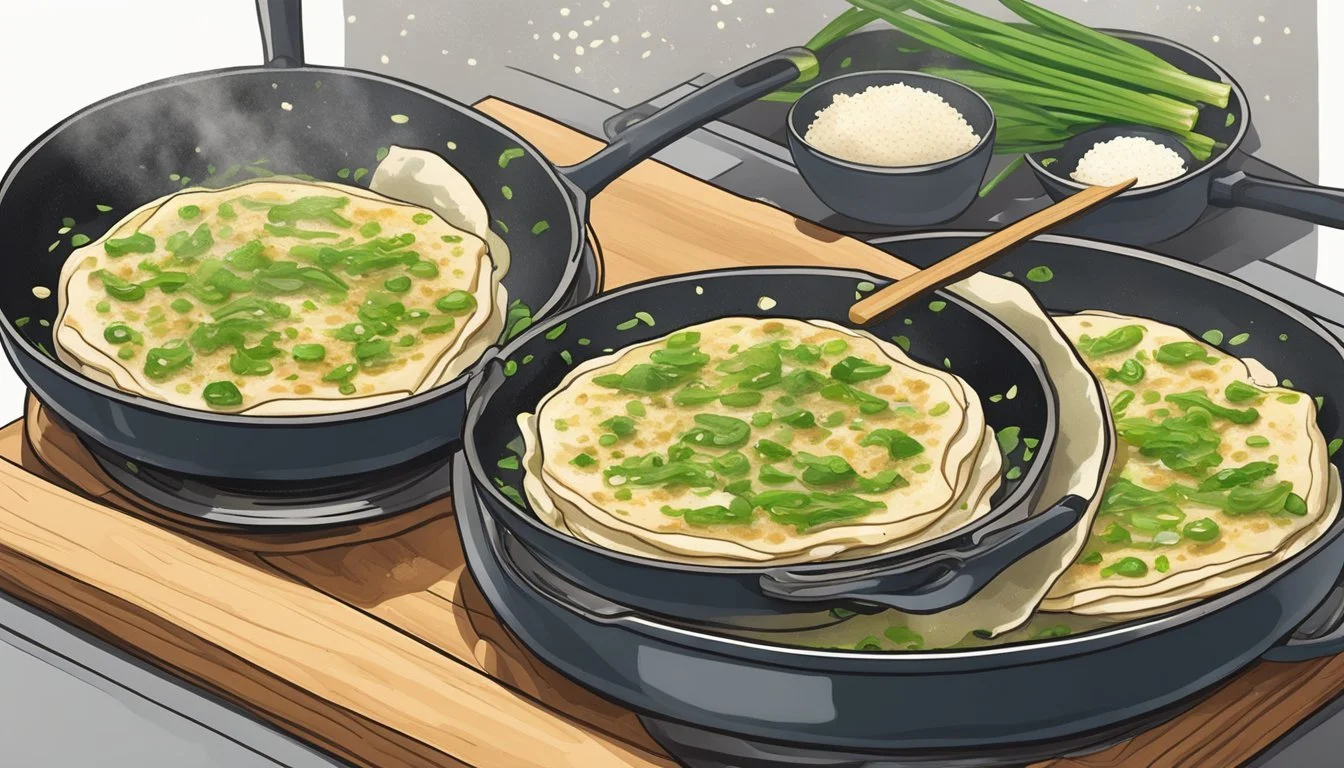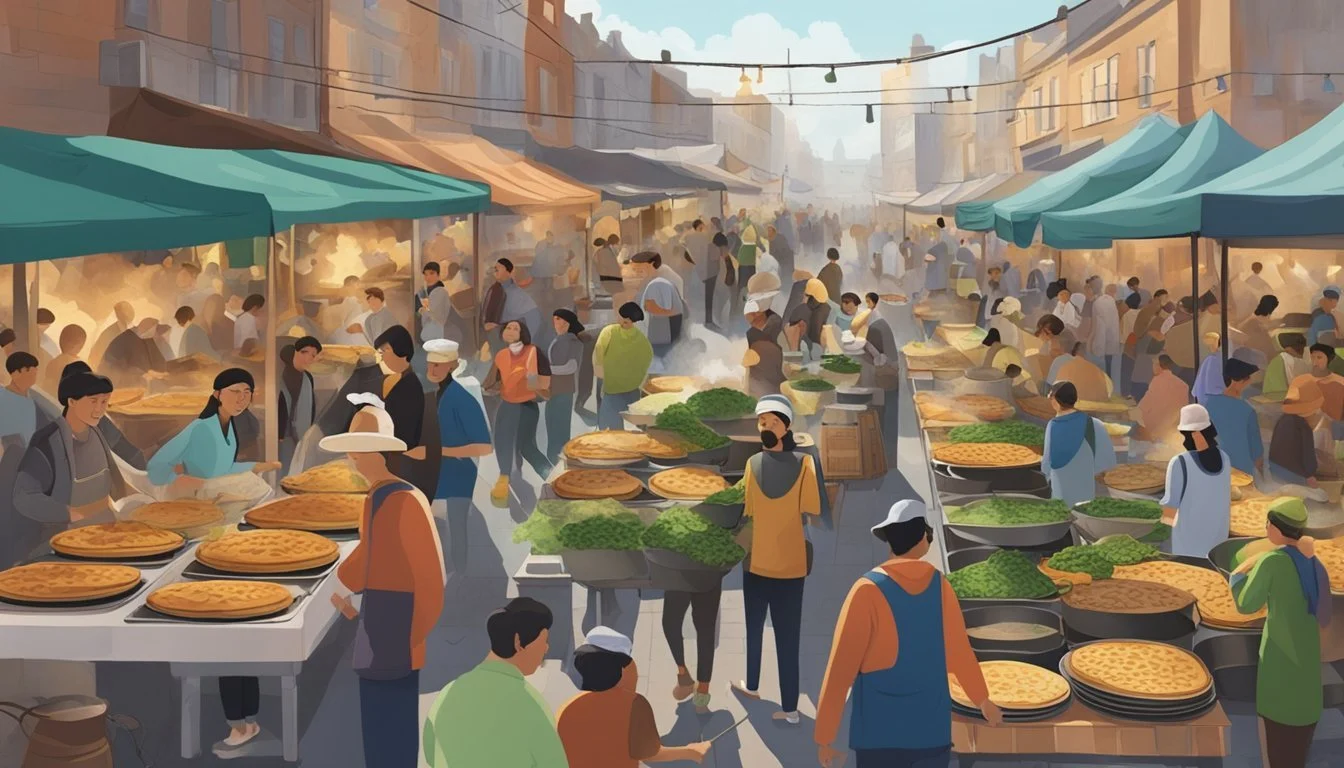Best Way to Reheat Scallion Pancakes
Ensuring Crispiness and Flavor Preservation
Scallion pancakes, a beloved Asian appetizer known for their crisp edges and savory flavor, often grace the tables of food enthusiasts. To preserve their delicious qualities outside the fresh cook environment, reheating them requires a method that maintains their original texture and taste. Achieving a perfect reheating method ensures that the pancakes remain as crispy and flavorful as when they were first made, engaging the senses with every bite.
Oven reheating offers a balanced approach that evenly warms the pancakes without sacrificing their crispiness. By lining a baking sheet with parchment paper or aluminum foil and arranging the scallion pancakes in a single layer, they can be rejuvenated. A light brushing of oil can help to restore the fried exterior to its former glory. Covering the sheet tightly with aluminum foil traps the moisture, preventing the pancakes from drying out while allowing them to heat through evenly.
For smaller portions or a quicker solution, an air fryer can provide an efficient way to reheat scallion pancakes. By heating at a controlled temperature, an air fryer crisps the edges without overcooking the center, retaining the pancake's tender layering. This method excels at delivering a rapid burst of heat, which is ideal for reviving the scallion pancakes to near-original condition in just a few minutes.
Understanding Scallion Pancakes
Scallion pancakes, known as "cong you bing" in Mandarin, are a savory, non-leavened flatbread folded with oil and minced scallions. Unlike their Western breakfast counterparts, these pancakes are enjoyed for their flaky texture and the burst of onion flavor.
Defining the Dish
Scallion pancakes are a staple in Chinese cuisine and are characterized by multiple layers of dough and scallions. They are traditionally made by rolling dough flat, sprinkling it with chopped scallions, rolling it into a log, and then coiling it into a round before rolling it flat again. This process creates a layered pastry that, once pan-fried, offers a crispy texture and rich, savory flavor.
Importance of Texture and Flavor
The key to an authentic scallion pancake is its texture and flavor. Crispiness is vital; it differentiates a well-prepared scallion pancake from a softer, less appetizing version. When properly reheated, the pancake should have a crispy exterior with a tender, flaky interior. Complementing the texture is the distinctive taste provided by the scallions, which should be fresh and aromatic, elevating the overall deliciousness of the dish. The balance of a crispy bite and the recognizable onion flavor is essential in achieving the traditional scallion pancake experience.
Pre-Reheating Tips
Before reheating scallion pancakes to achieve that desirable crispy texture and rich flavor, one must consider how they were stored and prepared for reheating. Proper initial storage is crucial, and following optimized preparation steps ensures the pancakes retain their quality.
Proper Storage
For the best results when reheating, scallion pancakes should be stored correctly. If they are to be consumed within a day or two, placing them in the fridge in an airtight container, separating each pancake with parchment paper to prevent sticking, is recommended. For longer storage, scallion pancakes can be frozen:
Short-term storage:
Refrigerate in an airtight container.
Place parchment paper between pancakes.
Long-term storage:
Wrap each pancake individually in aluminum foil.
Seal in a plastic bag before placing in the freezer.
Freezing helps maintain the pancakes' structural integrity and flavor for up to two months. Always ensure they are tightly sealed to avoid freezer burn.
Preparation for Reheating
Proper preparation for reheating begins with thawing frozen pancakes. They should be defrosted in the refrigerator overnight to maintain their consistency. Pancakes stored in the fridge can go directly to reheating, but let them reach room temperature for a few minutes to ensure even heat distribution. It is important not to skip these steps to preserve the pancakes' intended texture and flavor.
Reheating Techniques
Choosing the right reheating method is crucial for retaining the crispy texture and flavorful essence of scallion pancakes. Below are dependable techniques specifically tailored to various kitchen appliances.
Oven Method
For a uniformly heated and crisp result, they can reheat scallion pancakes in the oven.
Preparation:
Preheat the oven to 350°F (175°C).
Place the pancakes in a single layer on a non-stick baking sheet.
Execution:
If desired, brush a light coating of vegetable oil on the pancakes.
Reheat for about 5 to 10 minutes.
Stovetop Method
The stovetop method is preferred for achieving a crisp exterior quickly.
Setup:
Heat a non-stick skillet or frying pan over medium heat.
Add a small amount of oil to aid in crisping.
Reheating:
Place the scallion pancakes in the pan, ensuring they don't overlap.
Cook for 2 to 3 minutes on each side.
Toaster Oven Approach
Toaster ovens are effective for reheating smaller quantities of scallion pancakes, lending a crispy texture.
Preparation:
Set the toaster oven to 350°F (175°C).
Arrange the pancakes on a toaster oven tray.
Execution:
Toast for 5 to 7 minutes, monitoring to avoid over-browning.
Microwave Instructions
While not ideal for crispiness, the microwave can be used for a quick reheat.
Method:
Position the scallion pancakes on a microwave-safe plate.
Use the reheat setting or 50% power and warm for 30 seconds to 1 minute, checking periodically.
Air Fryer Strategy
An air fryer can offer a quick and extremely crisp finish.
Setup:
Preheat the air fryer to 350°F (175°C).
Lightly oil the basket to prevent sticking.
Reheating:
Place the pancakes in the basket in a single layer.
Heat for 3 to 4 minutes or until appropriately crispy.
Enhancing Crispiness Post-Reheat
After reheating scallion pancakes, the challenge is to ensure that they regain their signature crispiness. Using additional crisping techniques and fats effectively can elevate the texture and flavor.
Additional Crisping Techniques
To promote crispiness, one might consider using a conventional oven. After reheating, place the pancakes under the broiler for a brief period, monitoring closely to prevent burning. This technique will help achieve a desirable golden-brown exterior.
Alternatively, a toaster oven set to a light toast cycle can apply direct heat to the surface, crisping the pancakes without overcooking the interiors.
Using Fats for Enhanced Flavor
To infuse scallion pancakes with a flavorful edge while enhancing their crispiness, brushing a light coat of vegetable oil or melted butter on both sides of the pancake before reheating is beneficial. Not only does the fat help in evenly distributing the heat, but it also contributes to the development of a deliciously crispy texture.
Butter will add a rich, savory note.
Vegetable oil is a neutral option that can maintain the original flavor profile of the pancakes.
For best results, using a non-stick pan over medium-high heat to warm the pancakes allows the added fats to create a crispier exterior.
Serving and Toppings
When serving reheated scallion pancakes, the choice of complementary dishes and flavorful toppings can transform them from a simple snack into a gourmet experience. The right accompaniments not only provide a balance in flavors but also enhance the pancake's texture and taste.
Complementary Side Dishes
Reheated scallion pancakes are versatile and can transition from breakfast to dinner with ease. For a breakfast setting, they pair exceptionally well with a classic soy milk or a refreshing cucumber salad, offering a blend of crispy and refreshing textures. For more substantial meals, they serve as an ideal side dish alongside:
Dim Sum: Adding a variety of small bites like dumplings or steamed buns.
Stir-fried vegetables: Providing a nutritious and colorful addition to the meal.
Noodle dishes: Combining them with heartier textures and rich flavors.
Flavorful Topping Ideas
Enhancing scallion pancakes with toppings is an excellent way to elevate their flavor profile. For those who prefer a hint of sweetness, a light sprinkling of sugar satisfies without overpowering the savory notes of the pancakes. On the other hand, sesame seeds offer a nutty crunch that complements the scallion's mild sharpness. Creative and indulgent toppings include:
A dollop of ice cream: For a unique dessert twist, especially with pancakes that carry a hint of sweetness.
A variety of sauces: Such as hoisin or a spicy Sriracha mayonnaise, to add a kick or a savory touch.
Using these toppings and side dishes, one elevates the humble scallion pancake to a culinary delight, whether it's the start of the day or an accompaniment to a larger meal.
Handling Leftovers
Properly storing and reheating scallion pancakes can keep them crisp and delicious for later enjoyment. Ensuring leftovers maintain their flavor and texture requires attention to detail during both the storage and reheating process.
Storing and Freezing Leftovers
One should store leftover scallion pancakes in the refrigerator if they plan to eat them within a couple of days. For optimal freshness, the pancakes should be wrapped tightly in plastic wrap or aluminum foil, or placed in an airtight container.
Refrigerator: Store up to 2-3 days.
Airtight Container: Keeps moisture out.
For longer storage, freezing is an effective method. To freeze scallion pancakes, one must first let them cool to room temperature to prevent condensation, which can lead to a soggy texture upon reheating. Then, wrap them individually in plastic wrap and place them in a freezer-safe bag or container.
Freezing: Individually wrapped, lasts up to 3 months.
Defrosting: Thaw overnight in the refrigerator or at room temperature before reheating.
Making the Most of Next-Day Pancakes
When reheating leftover scallion pancakes, the goal is to restore their original crispy exterior and warm, flavorful interior. If pancakes have been refrigerated, they can be heated in an oven preheated to 350°F (175°C) for about 10 minutes on a baking sheet lined with parchment paper or foil. For added crispness, a light brush of oil before reheating can be beneficial.
Oven: Preheated to 350°F, 10 minutes until hot.
Added oil: For extra crispiness.
If the pancakes are frozen, one should first defrost them to ensure even warming. They can then be heated in the same way as refrigerated pancakes. Those in a hurry can use a toaster to warm straight from the freezer, but it may require an additional 30-60 seconds of toasting time.
Defrost Before Toasting: Ensures even heating.
Toaster: Add 30-60 seconds if from frozen.
Scaling for Large Crowds
When preparing scallion pancakes for large crowds, it's essential to consider the bulk prepping and the reheating process to maintain the quality of the food served. One must handle the larger volume without sacrificing the crispness and flavor that make scallion pancakes a sought-after dish.
Prepping Scallion Pancakes in Bulk
For large events, chefs should prepare scallion pancakes ahead of time in large quantities. Using a consistent recipe is key to ensure that each pancake maintains the same thickness and size for even cooking. A short stack method is effective where pancakes are layered with parchment paper to prevent sticking and made ready for bulk cooking. Here is a brief guideline for prepping in bulk:
Mix the batter: Ensure the batter has the right proportions of flour, scallions, water, and salt for a uniform flavor. For a twist, one might opt to use buttermilk for a tangier taste.
Cook in batches: Fry each scallion pancake until golden brown and let it cool before stacking.
Create short stacks: Layer the pancakes with sheets of parchment paper in between and store them in the refrigerator or freezer in airtight containers.
Reheating for Events
The method of reheating is crucial; it can make or break the texture of scallion pancakes. For serving large crowds efficiently, here are steps to ensure pancakes are crispy and warm:
Preheat the oven: Set the oven to 350°F (175°C), which is optimal for reheating without overcooking.
Prep the baking sheets: Line baking sheets with parchment paper and arrange scallion pancakes in a single layer, leaving space between them to ensure even heat distribution.
Cover with foil: To prevent them from drying out, cover the pancakes with aluminum foil.
Reheat in batches: Place the baking sheets in the oven, and heat the pancakes until they are thoroughly warm, about 10-15 minutes depending on the quantity.
By following these structured steps, one can serve scallion pancakes to a large number of guests with the same quality as if they were cooked fresh.
Recipe Variations and Considerations
When reheating scallion pancakes, one may wish to make alterations to suit dietary restrictions or explore different regional twists to rejuvenate flavors. It's vital to adjust recipes with an understanding that any variation can affect the texture and taste, especially in the pursuit of maintaining a crispy exterior and fluffy interior.
Dietary Adjustments
Gluten-Free Alternatives: For individuals following a gluten-free diet, substituting all-purpose flour with a gluten-free blend is crucial. Take note that gluten-free flours may absorb more moisture and can result in a less crispy texture. The key is to experiment with different blends to find one that retains fluffiness without becoming too dense.
Vegan Variations: To accommodate a vegan diet, one must replace any animal-derived ingredients typically used in scallion pancakes, like butter. Using plant-based oils or butter substitutes can help in achieving the desired crispiness while still adhering to vegan principles.
Exploring Regional Recipes
Northern Style: Often, Northern variations of the recipe yield a thicker pancake with multiple layers. When reheating, one must ensure even heat distribution to keep the interior fluffy.
Southern Twist: In contrast, Southern styles can be thinner and crisper. A quick stovetop reheating in a non-stick pan with a touch of oil can bring back the fresh-made crunchiness without compromising the pancake's integrity.
Both dietary adjustments and regional exploration provide opportunities to tailor scallion pancakes to personal preferences or needs while striving to preserve their classic texture and rich flavor.






